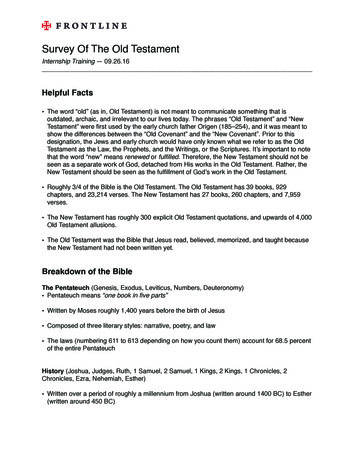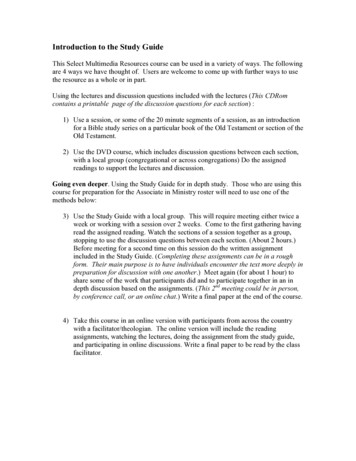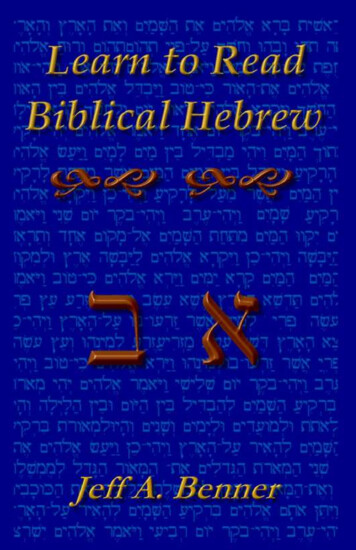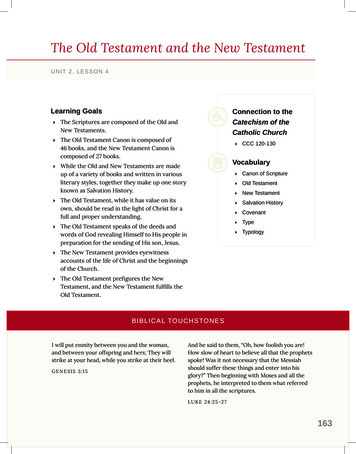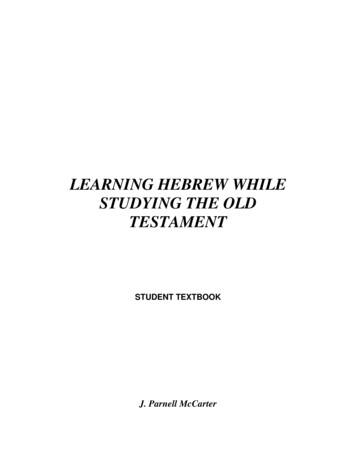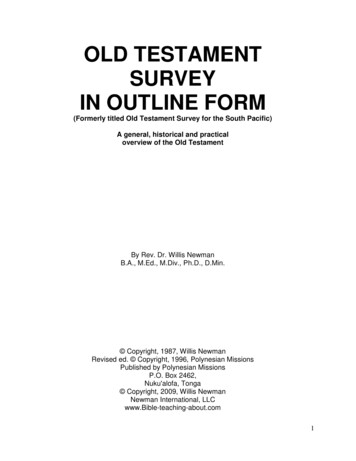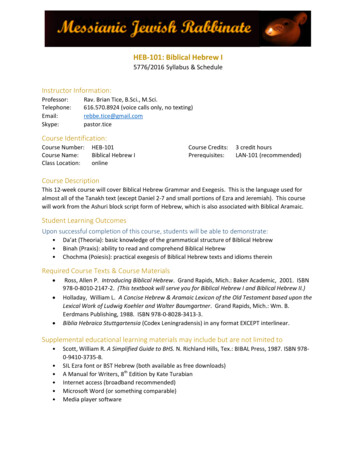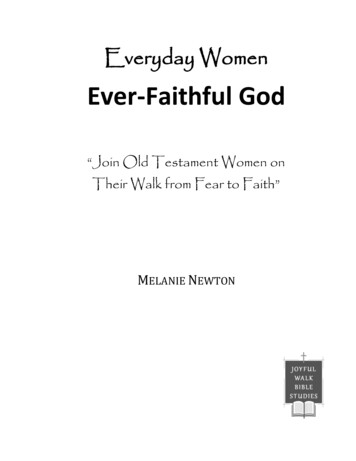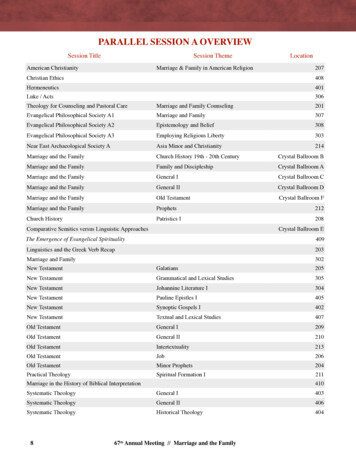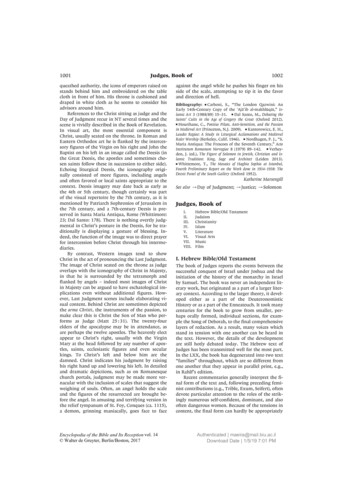
Transcription
1001Judges, Book ofqueathed authority, the icons of emperors raised onstands behind him and embroidered on the tablecloth in front of him. His throne is cushioned anddraped in white cloth as he seems to consider hisadvisors around him.References to the Christ sitting as judge and theDay of Judgment recur in NT several times and thescene is vividly described in the Book of Revelation.In visual art, the most essential component isChrist, usually seated on the throne. In Roman andEastern Orthodox art he is flanked by the intercessory figures of the Virgin on his right and John theBaptist on his left in an image called the Deesis (inthe Great Deesis, the apostles and sometimes chosen saints follow these in succession to either side).Echoing liturgical Deesis, the iconography originally consisted of more figures, including angelsand often favored or local saints appropriate to thecontext. Deesis imagery may date back as early asthe 4th or 5th century, though certainly was partof the visual repertoire by the 7th century, as it ismentioned by Patriarch Sophronios of Jerusalem inthe 7th century, and a 7th-century Deesis is preserved in Santa Maria Antiqua, Rome (Whittimore:23; Dal Santo: 178). There is nothing overtly judgmental in Christ’s posture in the Deesis, for he traditionally is displaying a gesture of blessing. Indeed, the function of the image was to direct prayerfor intercession before Christ through his intermediaries.By contrast, Western images tend to showChrist in the act of pronouncing the Last Judgment.The image of Christ seated on the throne as judgeoverlaps with the iconography of Christ in Majesty,in that he is surrounded by the tetramorph andflanked by angels – indeed most images of Christin Majesty can be argued to have eschatological implications even without additional figures. However, Last Judgment scenes include elaborating visual content. Behind Christ are sometimes depictedthe arma Christi, the instruments of the passion, tomake clear this is Christ the Son of Man who performs as Judge (Matt 25 : 31). The twenty-fourelders of the apocalypse may be in attendance, asare perhaps the twelve apostles. The heavenly electappear to Christ’s right, usually with the VirginMary at the head followed by any number of apostles, saints, ecclesiastic figures and even secularkings. To Christ’s left and below him are thedamned. Christ indicates his judgment by raisinghis right hand up and lowering his left. In detailedand dramatic depictions, such as on Romanesquechurch portals, judgment may be made more vernacular with the inclusion of scales that suggest theweighing of souls. Often, an angel holds the scaleand the figures of the resurrected are brought before the angel. In amusing and terrifying version inthe relief tympanum of St. Foy, Conques (ca. 1115),a demon, grinning maniacally, goes face to faceEncyclopedia of the Bible and Its Reception vol. 14 Walter de Gruyter, Berlin/Boston, 20171002against the angel while he pushes his finger on hisside of the scale, attempting to tip it in the favorand direction of hell.Bibliography: Carboni, S., “The London Qazwini: AnEarly 14th-Century Copy of the Ajā ib al-makhlūqāt,” Islamic Art 3 (1988/89) 15–31. Dal Santo, M., Debating theSaints’ Cults in the Age of Gregory the Great (Oxford 2012). Hourihane, C., Pontius Pilate, Anti-Semitism, and the Passionin Medieval Art (Princeton, N.J. 2009). Kantorowicz, E. H.,Laudes Regiae: A Study in Liturgical Acclamations and MedievalRuler Worship (Berkeley, Calif. 1946). Nordhagen, P. J., “S.Maria Antiqua: The Frescoes of the Seventh Century,” ActaInstitutum Romanum Norvegiae 8 (1979) 89–142. Verheyden, J. (ed.), The Figure of Solomon in Jewish, Christian and Islamic Tradition: King, Sage and Architect (Leiden 2013). Whittemore, T., The Mosaics of Haghia Sophia at Istanbul,Fourth Preliminary Report on the Work done in 1934–1938: TheDeesis Panel of the South Gallery (Oxford 1952).Katherine MarsengillSee also /Day of Judgment; /Justice; /SolomonJudges, Book ofI.II.III.IV.V.VI.VII.VIII.Hebrew Bible/Old TestamentJudaismChristianityIslamLiteratureVisual ArtsMusicFilmI. Hebrew Bible/Old TestamentThe book of Judges reports the events between thesuccessful conquest of Israel under Joshua and theinitiation of the history of the monarchy in Israelby Samuel. The book was never an independent literary work, but originated as a part of a larger literary context. According to the larger theory, it developed either as a part of the DeuteronomisticHistory or as a part of the Enneateuch. It took manycenturies for the book to grow from smaller, perhaps orally formed, individual sections, for example the Song of Deborah, to the final comprehensivelayers of redaction. As a result, many voices whichstand in tension with one another can be heard inthe text. However, the details of the developmentare still hotly debated today. The Hebrew text ofJudges has been transmitted well for the most part.In the LXX, the book has degenerated into two text“families” throughout, which are so different fromone another that they appear in parallel print, e.g.,in Rahlf’s edition.Recent commentaries generally interpret the final form of the text and, following preceding feminist contributions (e.g., Trible, Exum, Seifert), oftendevote particular attention to the roles of the strikingly numerous self-confident, dominant, and alsooften dangerous women. Because of the tensions incontent, the final form can hardly be appropriatelyAuthenticated maeira@mail.biu.ac.ilDownload Date 1/5/19 7:01 PM
1003Judges, Book ofexpounded without taking into account the earlierstages of redaction. Yet, this is contested primarilywithin English-speaking scholarship. Besides numerous monographs on smaller sections of Judges,many commentaries on the book of Judges have recently appeared.There are three main lines in terms of methodological treatments of the text. These range from establishing the foundation of the book by detailedredaction analyses (e.g., Groß) or by a rather largescale analysis of the layers of redaction. These largescale analyses reveal three clearly different “voices”in Judges (Niditch). Other methods interpret onlythe final form; although they do not reject theoriesof the historical origins of the text, they considerthem irrelevant for interpretation (e.g., Webb [seehis extensive history of research]). Still othermethods embark from the extreme hypothesis thatalmost the entire book is the work of one author,namely the author of the Enneateuch. This methodvirtually forces one to look for a unifying conceptin terms of content and has inevitably led to boththe more frequent acceptance of irony in the textand to the misinterpretation of not just a few passages (Frolov).The last few decades have yielded extensive newarchaeological materials and deeply expanded topographical knowledge (cf. Gaß). However, since thesediscoveries do not often comply without strain tothe indications found in Judges, more recent historical studies draw upon the narratives in Judges onlyvery cautiously.The narratives of the “major judges” (startingfrom 3 : 7) are generally recognized as the core ofthe book. In each of these deuteronomisticallyshaped narratives, YHWH comes to the rescue ofIsrael in times of self-inflicted distress. Primarilydebated is whether the Samson narrative belongs tothis core or whether it was added later, and howthe depiction of Eli, Samuel, and his sons in 1 Sam1–12 relate to it. The narratives of the Judges(Ehud, Deborah, Gideon, Jephthah) are bound bysimilar formulae, or are made up almost entirely offormulae (Otniel).The transition from the book of Joshua (Judg2 : 6–10) establishes that the period of the Judgescomprised a distinct epoch in the history of Israelmarked by the rise of a new generation that wasunaware of the preceding history of salvation (cf.Judg 2 : 10). Judges 2 : 11–3 : 6 provides the deuteronomistic pattern as an interpretation guide forthis period. One finds the regular repetition of theapostasy of the people, the handing over to enemies, the cry for help of the Israelites to YHWH, theappointment of a militarily victorious judge, andmention of the duration of his rule. The passagefrom 2 : 6 to 3 : 6 is literarily diverse. It assesses theeffectiveness of the Judges in different ways andcontains, like the book of Joshua, two conceptionsEncyclopedia of the Bible and Its Reception vol. 14 Walter de Gruyter, Berlin/Boston, 20171004of the conquest of the land. According to the olderconception, Israel completely seized its area of settlement under Joshua. According to the later conception, the periphery still had to be seized (Blum).The continued existence of previous inhabitants isgiven different theological explanations.The claim has not gained acceptance that thedeuteronomistic author, writing from a perspectiveof unified all-Israel, was the first to summarize andedit the disparate, magnificently told (and partiallylegendary) episodes of tribal heroes who fought fortribes or tribal groups (Becker). This is because theformulas of the deuteronomistic framework, whichascribe the respective threats to Israel to its worshipof other deities, find no resonance in the actual narration of the individual episodes. The thesis ofWolfgang Richter, however, has been repeatedlyconfirmed, though with varying chronological estimates. According to Richter a compilation of heronarratives limited to the later Northern kingdomof Israel was available to the Deuteronomist. Thiscompilation was already opposed to dynasty, critical of the monarchy (cf. Judg 8 : 22–23; the Jothamparable and the narrative of King Abimelech) andwas oriented from a perspective presuming a unified Israel (cf. Richter, Scherer, Guillaume). TheDeuteronomist completed the episodes in a pro-Judah perspective (Othniel), brought them into achronological sequence, and transformed them intonarratives of guilt and punishment according to hiscultic interpretation of history.The discussion concerning Judges is also influenced by newer controversies surrounding the Deuteronomistic History and the Enneateuch. Theopinion is widely held that the hero narrativesoriginating in what would later become the Northern kingdom, albeit already providing a perspectiveof Israel as a whole, were edited – by means of theabovementioned deuteronomistic patterns and formulae – by the same author who created the entireDeuteronomistic History (Deut–2 Kgs) from a variety of sources.Of the various overarching theories, one shouldbe mentioned: according to this theory, a later Deuteronomist was the first to bind the earlier deuteronomistic Hexateuch, which ended with Joshua,with a Deuteronomistic History that only spannedfrom 1 Sam–2 Kgs. This Hexateuch and Deuteronomistic History were combined with the deuteronomistic edition of the Judges narratives to create theEnneateuch (Kratz).Judges 1–2 : 5 and 17–21 are quite differentlyarranged. They know of no individual dominanthero figures, but rather deal with large collectives,tribes, or the assembly of Israel, without any identified leaders. Judges 1 gives information on the military inability of the tribes of Israel and their consequent incomplete conquest of the land. Judges 17–18 illustrate the YHWH cult run wild by referenceAuthenticated maeira@mail.biu.ac.ilDownload Date 1/5/19 7:01 PM
1005Judges, Book ofto the inglorious story of the tribe of Dan. Judges19–21 tells how Israel reacts self-destructively to asocial misdeed: The sacral federation of tribes avenges a sexual offence covered up by an entire tribe(Benjamin). The offence is punished by means ofinner-Israelite annihilation according to Torah, butthe tribe is nevertheless safeguarded subsequentlythrough double-casuistic circumvention of an oathbefore the tribe’s downfall. While almost all of theparticulars remain controversial, more recent commentaries agree (in opposition to older commentaries) that ch. 17–21 are not “appendices”, but framethe book together with ch. 1. They share a pro-Judah tendency, to which correspond a positive assessment of the (Davidic) kingdom in 17 : 6, 18 : 1,19 : 1, and 21 : 25 and perhaps an (anti-Saulide?)anti-Benjamin tendency in chs. 17–21. This framing of the older deuteronomistic text elements ispostexilic and post-deuteronomistic, and possessesan Enneateuchal horizon. This framing depicts theuntenable conditions of Israel before it became anational state and indirectly depicts the necessity ofthe monarchy. The framing also segues factuallyinto the history of the Israelite kingdoms in 1 Sam–2 Kgs, although not by means of narrative.There exists no consensus about the dating ofthe pre-deuteronomistic text elements, since all ofthe important details of the development of Judgesand even the existence of pre-deuteronomistic textsremain disputed. Three primary pieces of evidencein the quest for these very old texts are discussed:(1) the text of the Song of Deborah in Judg 5 : 2–31ab, which is unfortunately poorly handed downand which in several places is no longer clearlyunderstandable. It may be that the song was composed in the 10th century in the setting of a selfconstitutive kingdom among the northern tribes(Knauf). (2) The anti-monarchic parable of Jotham,without reference to Abimelech, in Judg 9 : 8–15d,which is impossible to date. (3) The narrative of theinfamous deed in Gibeah in 19 : 1c–30 (the continuation in 20–21 is post-deuteronomistic and postexilic). This text was perhaps a pro-Davidic, anti-Benjaminite, and indirectly anti-Saulide pamphletdirected at the northern tribes. It would have thencome from the time in which David still had to secure his rule over the north from his location inJerusalem (Stipp).Bibliography: Becker, U., Richterzeit und Königtum: Redaktionsgeschichtliche Studien zum Richterbuch (BZAW 192; Berlin/New York 1990). Blum, E., “Der kompositionelle Knotenam Übergang von Josua zu Richter: Ein Entflechtungsvorschlag,” in Deuterononomy and Deuteronomic Literature, FSC. H. W. Brekelmans (ed. M. Vervenne/J. Lust; BEThL 133;Leuven 1997) 181–212; repr. in id., Textgestalt und Komposition (FAT 69; Tübingen 2000) 249–80. Exum, J. C., Fragmented Women (JSOTSup 163; Sheffield 1993). Frolov, S.,Judges (FOTL 6B; Grand Rapids, Mich. 2014). Gaß, E., DieOrtsnamen des Richterbuches in historischer und redaktioneller Perspektive (ADPV 35; Wiesbaden 2005). Groß, W., RichterEncyclopedia of the Bible and Its Reception vol. 14 Walter de Gruyter, Berlin/Boston, 20171006(HThKAT; Fribourg 2009). Guillaume, P., Waiting for Josiah (JSOTSup 385; London 2004). Knauf, E. A., “Deborah’s Language,” in Studia Semitica et Semitohamitica, FS R.Voigt (ed. B. Burtea et al.; AOAT 317; Münster 2005) 167–82. Kratz, R. G., Die Komposition der erzählenden Bücher desAlten Testaments (UTB 2157; Göttingen 2000); ET: The Composition of the Narrative Books of the Old Testament (London 2005). Niditch, S., Judges (OTL; Louisville, Ky./London 2008). Richter, W., Traditionsgeschichtliche Untersuchungen zum Richterbuch (BBB 18; Bonn 21966). Scherer, A., Überlieferungenvon Religion und Krieg: Exegetische und religionsgeschichtliche Untersuchungen zu Ri 3–8 und verwandten Texten (WMANT 105;Neukirchen-Vluyn 2005). Seifert, E., Tochter und Vater imAlten Testament (NThDH 9; Neukirchen-Vluyn 1997). Stipp, H.-J., “Richter 19: Schriftgestützte politische Propaganda im davidischen Israel,” in id., Alttestamentliche Studien(BZAW 442; Berlin/Boston, Mass. 2013) 171–244. Trible,P., Texts of Terror (OBT 13; Philadelphia, Pa. 1984). Webb,G. B., The Book of Judges (NICOT; Grand Rapids, Mich.2012).Walter GroßII. Judaism Second Temple and Hellenistic Judaism RabbinicJudaism Medieval Judaism Modern JudaismA. Second Temple and Hellenistic JudaismThe earliest reference to an actual “book of Judges”comes from the 1st-century CE work of Philo of Alexandria, De confusione linguarum (26.128). It is possible, however, that a written work is in mind inSir 46 : 11–12, which refers to “the judges, eachwith his own name” (NETS). The events of the bookare more often conceived as belonging to a particular historical period immediately preceding themonarchy (e.g., Ruth 1 : 1; 2 Kgs 23 : 22; Isa 1 : 26;2 Bar. 60 : 2).1. The Textual History of Judges. The textual history for the book of Judges in the Second Templeand Hellenistic periods is quite complex, and weare presented with a multiplicity of manuscript traditions. There exist two markedly different Greekversions of the book, represented by Codex Vaticanus and Codex Alexandrinus. The Vaticanus text ofJudges offers a highly literal translation, very closeto that of MT, which has been linked with the kaigerecension of the LXX. The Alexandrinus text ofJudges, on the other hand, exhibits greater freedomin word order and contains several large expansions, frequent doublets, and small additions clarifying the meaning of the text. This text is oftenidentified as the Old Greek text of Judges as preserved in the Hexaplaric, Lucianic, and later Byzantine witnesses.Amongst the DSS, three fragmentary manuscripts of Judges have been discovered – 1Q6(1QJudg), 4Q49 (4QJudga), 4Q50 (4QJudgb). Together these represent parts of thirteenof the twentyone chs. The oldest of these MSS, 4QJudga, isdated to the late Hasmonean or early Herodian period (approx. 50–25 BCE; Lange also dates 1QJudgto this period, but Barthélemy places it in the 1stAuthenticated maeira@mail.biu.ac.ilDownload Date 1/5/19 7:01 PM
1007Judges, Book ofcent. CE). While at times these texts agree with MTor Greek versions, they also present several independent readings. The most marked divergence occurs in 4QJudga, which contains Judg 6 : 2–13,omitting vv. 7–10. Some scholars have viewed theabsence of these verses, which have long been identified by literary critics as a later insertion (e.g.,Wellhausen: 214–15), as confirmation of the existence of an earlier, abbreviated form of the text,thus representing an independent or unalignedtext-type (e.g., Lange). Others, however, maintainthat the MS may instead preserve a late rearrangement and that these verses could have been included in a different position or that the text couldhave been a compilation rather than a copy ofJudges (Fernández Marcos). Due to the fragmentarynature of the MS, though, a confident determination cannot be made.An additional MS of unknown provenance (X6[XJudg]) has also been published. Although it wasfirst tentatively labeled 4QJudgc, there is no evidence for its association with Cave 4 and it seemslikely that it originated from a different cave. Thehandwriting is classified as either late Herodian(50–68 CE) or post Herodian (75–135 CE; Eshel etal.). This MS contains fragments from chs. 1, 3, 4,and offers no variants from MT.Two additional texts are probably related toJudges. 4Q559 contains a chronology of Israelitehistory, including three judges, Othniel, Ehud(along with Eglon) and Shamgar. 4Q551 presents ascene reminiscent to that of Judg 19 : 22–23 or Gen19 : 4–8.2. Retellings in Josephus and Pseudo-Philo. Josephus’ retelling of Judges in Ant. 5.120–317 israther different from that of either the MT or Greekversions. It preserves a different order of material,beginning with the story of the rape of the Levite’sconcubine and the ensuing civil war (5.136–174;she is, however, the Levite’s wife in Josephus’ recounting) and concluding with the Samson narrative (5.276–317). Additionally, Josephus omits several scenes, including the Song of Deborah, theaccount of Gideon’s testing God and smashing thealtar of Baal, and the story of Micah’s idolatry. Ithas been suggested that Josephus may have used aTargum of Judges as his source rather than the biblical text itself (Thackeray: 81). His retelling produces a more logical and harmonious text in that heconsistently changes the stories to omit repetitionsand inconsistencies. Several further changes areevident in his replacement of angels with alternative formulations, an emphasis on prophecy anddreams, and the correcting of immorality or inappropriate theology. Perhaps the largest consistentchange is that contrary to the biblical text, whereIsraelite sin is most usually characterized as theworship of foreign gods, in Antiquities it is the neglect of the laws and disregard for the constitutionEncyclopedia of the Bible and Its Reception vol. 14 Walter de Gruyter, Berlin/Boston, 20171008that leads to the destruction of the Israelite tribes(see Tuval: 167–70).In Pseudo-Philo’s Liber antiquitatum biblicarum,Judges is recounted in 24.6–48.4. The order of material closely follows the biblical progression ofjudges, except in the case of the first judges, whereKenaz and Zebul replace Othniel, Ehud, and Shamgar. In Liber antiquitatum biblicarum an extensiveamount of space is devoted to the judgeship ofKenaz (25–28), second only to the amount of spacedevoted to Moses (9–19). The name Kenaz does appear in the Book of Judges once, where he is namedas the father of the first judge, Othniel (describedin only two brief verses; Judg 3 : 10–11). Similarly,the name of the second judge, Zebul (29), also appears in Judges, although in an entirely differentcontext (9 : 28 where he is the lieutenant of Abimelech). Zebul is followed by Deborah (30–33) andthen by Ehud, who is not identified as a judge butrather as a Midianite sorcerer (34). The progressionof judges then follows that of the biblical book,ending with the refrain that “in those days therewas no king in Israel and every man did what wasright in his own eyes” (Judg 21 : 25 LAB 48.4). LikeJosephus’ retelling of the biblical episodes, that ofPseudo-Philo presents numerous differences fromthose of the MT and Greek versions in order topresent a more coherent text. The narratives of chs.1, 3, and 18 are omitted (distribution of land,Ehud’s murder of Eglon and the migration of theDanites). He consistently fills in details, givingnames to unnamed characters (especially angels)and providing clearer motives for the characters’ actions. He also systematically increases the size ofarmies, the number of deaths after war, and theyears for the judges’ reigns.Bibliography: Barthélemy, D., “Juges (Pl. XI),” in QumranCave I (ed. id./J. T. Milik; DJD 1; Oxford 1955) 62–64. Bodine, W. R., The Greek Text of Judges (HSM 23; Chico, Eshel, E. et al., “A New Fragment ofCalif. 1980).XJudges,” DSD 14.3 (2007) 354–58. Fernández Marcos,N., “The Hebrew and Greek Texts of Judges,” in The EarliestText of the Hebrew Bible (ed. A. Schenker; Leiden 2003) 1–16. Lange, A., Handbuch der Textfunde vom Toten Meer, vol. 1(Tübingen 2009). Niditch, S., Judges (OTL; Louisville, Ky./London 2008). Thackeray, H. S. J., Josephus: The Man and Trebolle Barrera, J.,the Historian (New York 1967).“4QJudga–b,” in Qumran Cave 4, IX (ed. E. Ulrich/F. M. Cross;DJD 14; Oxford 1995) 165–70. Tuval, M., From JerusalemPriest to Roman Jew: On Josephus and the Paradigms of AncientJudaism (WUNT.2 357; Tübingen 2013). Webb, B. G., TheBook of Judges (NICOT; Grand Rapids, Mich. 2012). Wellhausen, J., Die Composition des Hexateuchs und der historischenBücher des Alten Testaments (Berlin 21889).Amanda M. Davis BledsoeB. Rabbinic JudaismNo sustained or systematic rabbinic commentaryexists for the book of Judges comparable to thoseon the books of the Pentateuch, although later anthologies such as the medieval Yalqut Shim oni andAuthenticated maeira@mail.biu.ac.ilDownload Date 1/5/19 7:01 PM
1009Judges, Book ofLouis Ginzberg’s Legends of the Jews (1909–38) wereeventually compiled.1. Overall Conceptions of the Period of Judges.The Geonic-period work Seder Tanna im we-Amora imbegins by listing those involved in passing on theTorah, i.e., the oral law, from Moses down to themen of the Great Assembly. The list mentions everyjudge in the book of Judges, even unlikely choicessuch as Abimelech and Samson, and (according tocertain MSS) that all of these people communicatedwith the divine Spirit.That the judges were essentially rabbis is thepremise of an important rabbinic dictum whichglosses two biblical verses. Deuteronomy 17 : 9states that litigants must go to “the judge who sitsat this time.” “What other judge could one go to?”the commentators ask (MidAg, ad loc.). Rather itteaches that each generation must venerate its ownjudges, regardless of how they compare to those ofother generations.A more concrete version of this dictum comesas a gloss to Samuel’s speech to the Israelites (1 Sam12 : 11) in which he lists four heroes that YHWHsent to save the Israelites, Jerubbaal, Bedan ( Samson in rabbinic tradition), Jephthah, and Samuel.The rabbis connect this to Ps 99 : 6, where Mosesand Aaron are made parallel to Samuel, and theycomment (bRH 25b) that “three lesser figures areanalogized to three great figures, to teach you thatJerubbaal in his generation is like Moses in his, Bedan in his generation is like Aaron in his, and Jephthah in his generation is like Samuel in his.”The significance of having had one member ofeach tribe as a judge is underlined by the rabbis’claiming that one tribe (Simeon) contributed nojudge because of the stain of Zimri’s sin with theMidianite princess Cozbi (Num 25 : 14–15; MidrashPinchas ben Yair in OtsMid, 575).2. Evaluations of Individual Characters inJudges: A (Selective) Survey. Othniel ben Kenazwas a great Torah scholar. Moses’ father-in-law, Hobab, went to live near him and study Torah (SifDev352). When many halakhot were forgotten uponMoses’ death, Othniel’s keen analysis rediscoveredthem (bTem 16a). Similarly, the reference to Ehudben Gera’s two-edged sword was a hint at his ownprowess in Torah study, which gives a person rewards both in this world and the world to come(Tan Wa-yeḥi 14).Deborah’s husband, whom the Midrash identifies as Barak ben Abinoam (see “Barak”), was an ignoramus. He was a candlewick maker (whence hisname Lapidot; Judg 4 : 4) and she sent him to bringhis wicks to the bet midrash (study house) in Shiloh.He made the wicks extra thick to allow more timefor night study, and was rewarded with the worldto come (SER 10). Another tradition has it that Deborah appointed Barak to lead the war effort becausehe served the elders as an apprentice Torah studentEncyclopedia of the Bible and Its Reception vol. 14 Walter de Gruyter, Berlin/Boston, 20171010before and after Joshua’s death (YalqShim 2.42).Deborah herself taught Torah to all Israel; she satunder the tree because it would have been inappropriate for a woman to be alone with male studentsinside a building (ibid.).To catch Sisera off his guard, Yael had to seducehim. When he asked for water, she gave him herbreasts from which to suckle (bNid 55b; Roqeaḥ onHaftarot, “Beshallaḥ”). The two had intercourseseven times that night (bYev 103a). Nevertheless,Yael was an exceedingly modest woman, and shepurposefully killed Sisera with a tent peg as opposed to a sword, since a woman’s use of a sword isforbidden as a form of cross dressing (YalqShim,2.56). As for Sisera, as wicked as he was, his descendants became Jewish and even taught Torah toyoung boys in Jerusalem (bGit 57b). The rabbis usethe description of his wicked mother’s mourningcry to derive some of the laws of shofar blowing(bRH 33b).Abimelech is particularly unpopular with therabbis. He was worse even than Abimelech, king ofthe Philistines (Tan Wa-yera 25). Since he murderedhis seventy brothers on a stone, he was killed by amillstone cracking his head (Mishnat R. Eli ezer 9,p. 156). The proverb “Before destruction one’s heartis haughty” (Prov 18 : 12) is seen to refer to Abimelech, who was arrogant and ended up being killedby a woman, making him a laughing stock. Thecontinuation of the verse, “but humility goes beforehonor,” is a reference to his father Gideon, whoturned down the crown but was lauded by all Israelfor the remainder of his life (Tan Wa-yera 29).In Jotham’s fable, Abimelech is the thorn bush,who accepted the crown though undeserving of it,whereas the olive tree (Othniel), the fig tree (Deborah), and the grapevines (Barak and Gideon), allturned down the crown, though they were deserving of it (ibid.) Jotham cursed his brother fromMount Gerizim on purpose, in a polemical stanceagainst the future Samaritan heresy, since Gerizimis really the cursed mountain; those who deliveredthe curse standing on Mount Ebal were facing, andthus cursing, Mount Gerizim (ibid.).Jephthah’s rash vow could have been annulled.Phinehas son of Aaron was alive at the time, buthe said to himself, “I am the high priest, Jephthahshould come to me and ask to have it annulled.”Jephthah said to himself, “I am the leader of allIsrael, Phinehas should come to me and offer to annul it.” Because of their pride, the girl was lost, andeach was punished for it. Phinehas lost the abilityto hear God’s voice. Jephthah lost body parts, whichwould fall off periodically (BerR 60).Samson’s father Manoah was an ignoramus,since the verse says he followed after his wife, andthis is immodest behavior (bBer 61a). Samson, despite his great strength, was lame in both legs; welearn this from Gen 49 : 17, which describes him asAuthenticated maeira@mail.biu.ac.ilDownload Date 1/5/19 7:01 PM
1011Judges, Book ofa snake (bSot 10a). He was a giant man; the spacebetween his shoulders was sixty cubits in length(ibid.). This so impressed the Philistines that whenhe was in prison, every man with a wife of childbearing age brought her to Samson so that hewould to lie with her and impregnate her so theycould have giant sons (ibid.).The Bible spells the name of Jonathan’s grandfather with a floating nun (Judg 18 : 30) to be purposefully ambiguous; if he ended up righteous hewould be known as Moses’ grandson; otherwise asManasseh’s. The rabbis identify Jonathan with David’s treasurer, Shebuel (1 Chr 26 : 24). Samuel, therabbinic sage, was once asked how Jonathan couldhave lived such a long life if he was an idolater.Samuel answered because he was subtly workingagainst idolat
Eastern Orthodox art he is flanked by the interces-sory figures of the Virgin on his right and John the Baptist on his left in an image called the Deesis (in the Great Deesis, the apostles and sometimes cho-sen saints follow these in succession to either side). Echoing liturgical Deesis, the iconography origi-
